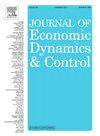Capital misallocation and economic development in a dynamic open economy
IF 1.9
3区 经济学
Q2 ECONOMICS
引用次数: 0
Abstract
Some countries, such as Canada, Italy, and Mexico, have experienced a higher growth rate of capital per worker but a lower growth rate for GDP per worker compared to the United States. This paper explains these two facts through the lens of a dynamic multisector open economy model where capital flows across countries. In the model, firms face sector-specific distortions on capital and intermediate inputs that influence the actual rate of return on capital and the aggregate total factor productivity (TFP). We calibrate the model to Mexico for the period 2000-2014 and show that changes in sectoral distortions and productivities reduced the actual rate of return on capital, triggering capital accumulation and a reduction in TFP. The results show that aggregate output decreased by 7.3% and aggregate capital increased by 10.6%. From 33 sectors (out of 48) that suffered productivity losses, approximately 50% accumulated more capital. Furthermore, the capital-intensive sectors explain 82% of the capital-output ratio increase.
动态开放经济中的资本错配与经济发展
与美国相比,加拿大、意大利和墨西哥等国的工人人均资本增长率较高,但工人人均国内生产总值增长率较低。本文通过一个资本在各国间流动的动态多部门开放经济模型来解释这两个事实。在该模型中,企业在资本和中间投入方面面临特定部门的扭曲,从而影响资本的实际回报率和全要素生产率(TFP)。我们对墨西哥 2000-2014 年期间的模型进行了校准,结果表明,部门扭曲和生产率的变化降低了资本的实际回报率,引发了资本积累和全要素生产率的下降。结果显示,总产出减少了 7.3%,总资本增加了 10.6%。在生产率下降的 33 个部门(共 48 个)中,约 50%的部门积累了更多的资本。此外,资本密集型部门占资本产出比增长的 82%。
本文章由计算机程序翻译,如有差异,请以英文原文为准。
求助全文
约1分钟内获得全文
求助全文
来源期刊

Journal of Economic Dynamics & Control
ECONOMICS-
CiteScore
3.10
自引率
10.50%
发文量
199
期刊介绍:
The journal provides an outlet for publication of research concerning all theoretical and empirical aspects of economic dynamics and control as well as the development and use of computational methods in economics and finance. Contributions regarding computational methods may include, but are not restricted to, artificial intelligence, databases, decision support systems, genetic algorithms, modelling languages, neural networks, numerical algorithms for optimization, control and equilibria, parallel computing and qualitative reasoning.
 求助内容:
求助内容: 应助结果提醒方式:
应助结果提醒方式:


